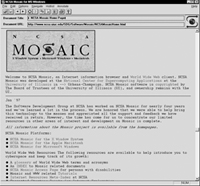
NCSA Mosaic 1.0, the first web browser that will achieve popularity among the general public, is released.

The web in the early 1990s was mostly text. People posted images, photos, and audio or video clips on web pages, but these pieces of multimedia were hidden behind links. If you wanted to look at a picture, you had to click on a link, and the picture would open in a new window.
A team of students at the University of Illinois National Center for Supercomputing Applications, or NCSA, decided the web needed something more stimulating and user-friendly, so they started building a better browser. Borrowing design and user-interface cues from some other early browsers, they went through a handful of iterations before release on April 22, 1993. NCSA Mosaic was the first web browser with the ability to display text and images in-line, meaning you could put pictures and text on the same page together, in the same window.
It was a radical step forward for the web. It took the boring document layout of your standard web page and transformed it into something much more visually exciting, like a magazine. And, wow, it was easy. If you wanted to go somewhere, you just clicked. Links were blue and underlined, easy to pick out. You could follow your own virtual trail of breadcrumbs backward by clicking the big button up there in the corner.
Windows and Mac versions came out in late 1993, and you could download them for free. Mosaic’s color and images made the web a pleasure to use.
Mosaic evolved into the Netscape Navigator in 1994. That browser dominated the fledgling web before ceding the browser throne to Internet Explorer. But Netscape came back as Mozilla, and then it found new life as Firefox.—MC